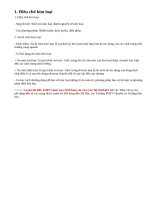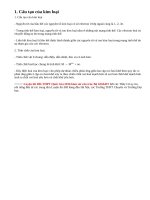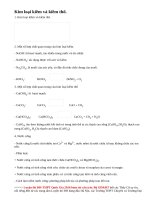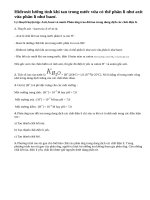Trans theory lý thuyết luyện tập
Bạn đang xem bản rút gọn của tài liệu. Xem và tải ngay bản đầy đủ của tài liệu tại đây (38.93 KB, 5 trang )
Trans Theory: Câu hỏi lý thuyết
Unit 3:
Exercise 1:
1. Adaptation (Free) is also called intralingual translation
F
2. In word-for-word translation, the most common meanings
of words are used despite some minor grammatical changes
3. In literal trans, words are translated singly by the most
common meanings and in context
4. Semantic trans is better than its original while
communicative trans is inferior to its original
5. Literal trans (WFW) is characterized by the preservation of
the SL word order
6. Communicative trans gives the translator less (more)
freedom of lexical choice than semantic translation
7. Semantic translation is written at the author’s linguistic level
so it’s personal
F
F
F
F
F
T
Exercise 2:
1. Semantic Translation focuses so much on aesthetic features of the ST that it
might result in the loss of ___________
2. Faithful translation transfers cultural words rather than ___________
3. According to Newmark, Translation Methods refers to the overall strategy
that a translator applies to a text as a whole
4. Free Trans is a method which reproduces the matter without the manner
and the content without the form of the original
5. In Literal Trans method, SL grammatical structures are converted to the
nearest equivalent in the TL, and words are translated singly & out of
context
6. Faithful Method refers to a method that generates precise contextual
meaning of the ST within the constraints of the TL grammatical structures
7. Applying _____Adaptation____ as a translation method, the translator also
performs the role of the ST rewriter.
8. In communicative translation, both the contents and the language are
readily acceptable and comprehensible to the reader.
Unit 1 & 2
Exercise 1
1. TL readership is always identical to SL readership.
2. The role of text analysis is to identify what the text is
about and how it is organized (guild the translation
process)
3. In terms of stylistic scales, there is a reciprocal
relationship between formality and emotional tone
4. The intention of the translator is always identical to that
of the text
Exercise 2:
F
F
T
F
1. Discussion is a treatment of ideas, so more emphasis is put on abstract
nouns, verbs of thought, mental activity, logical argument and connectives.
2. Setting of the text involves where the TT would be published as well as
which requirements the clients set. n
3. The intention of the text represents the attitude of the writer to the subject
matter.
4. The Readership is a group of audience that the text is aimed at. This group
is marked with level of education, class, age, sex, etc.
5. The uninformed is a group of readers with little knowledge about the
subject matter discussed in the text.
6. Three types of readership include expert, the educated layman and the
uninformed.
7. Four types of text include Narrative, Description, Discussion and dialogue.
8. Dialogue is the text type which puts much emphasis on two types of
expression: colloquialism & Phaticism
9. The average text for translation tends to be for educated, middle class
readership in an informal, not colloquial style.
10. Stylistic scales include scales of formality, generality and difficulty and
emotional tone.
Unit 4: Translation Procedure
Ex 1:
1. Modulation Descriptive Equivalent helps to generate clear
images of SL concepts to the TL readers
2. Naturalization Transference helps to maintain local color of the
SL
3. When cultural Equivalent is applied, a SL cultural word is
replaced by a TL neutral Cultural word
4. Through Trans is, by nature, a form of literal translation
5. Translation procedure refer to the overall strategy that a
translator applies to a text as a whole to a sentence or the
smaller units of language
6. Cultural Through translation is used for recognized terms such
as names of common collocation, etc.
7. Functional equivalent neutralized or generalized the source
language word.
8. Shift involves a grammatical change from the source language
to the target language
9. Applying transference, (Naturalization) a translator transfers
and adapts the source language word first to the normal
pronunciation, then to the normal morphology of the TL
10. Passive for active is a translation sub-procedure of
transposition modulation.
11. In couplets, two procedures are combined to translate an
entire sentence ( one single unit of language)
F
F
F
T
F
F
T
T
F
F
F
Ex 2:
1. Once the translator uses CULTURAL EQUIVALENT as a translation
procedure, an SL cultural word is translated by a TL cultural word
2. FUNCTIONAL EQUIVALENT is a trans strategy regarded as a way of
deculturizing a culture-specific concept.
3. The translator may apply the DESCRIPTIVE equivalent to bring a clearer
image of the SL concept to the TL readers.
Unit 5
Ex 1:
1. Connotative equivalence is achieved thru word choice
2. Text-normative equivalence is found in specific text types
3. Pragmatic equivalence (Text normative) relates to text-type
specific features or text and language norms for given text
types
4. Denotative equivalence (Connotative) is the equivalence of
the extra-linguistic content of a text, otherwise called
“stylistic equivalence”
5. Equivalence is by nature, an interlingual (INTRALINGUAL)
relationship
Interlingual: between 2 languages
Intralingual: between 2 text in 2 language
T
F
F
F
Ex2:
1. Formal equivalence focuses on the form of the text: rhythm, verse form,
word play, metaphor and so on.
2. Denotative equivalence is the one in which the SL and TL words refer to the
same things in the real world.
3. Equivalence is the __________ between a ST and a TT that allows the TT to
be considered as a translation of the ST.
4. One to part means a TL expression covers part of the concept designated by
a single SL expression.
5. To achieve pragmatic equivalence, text normative or even denotative
equivalence may be ignored.
Unit 7
Ex 1:
1. A translation may be accurate without being clear
2. In back- translation, the back translator writes out the meaning he
gets from the translation back into the source language after
reading the source text
3. In a readability test, the tester will listen and take notes of any
places where the reader hesitates
4. What is readable for one audience may not be readable for
T
F
T
T
another
Ex 2:
1. Three main criteria for accessing the quality of a translation include
accuracy, clarity and naturalness.
2. In back translation, the back translator should be bilingual in the source and
receptor language.
3. In comprehension tests, the respondents should be ordinary people from
various classes of the society who speaks the TL fluently.
EX 3:
1.
2.
3.
4.
5.
6.
B, G.
F
C, E
I, H
A
D
Unit 6: Trans Error
Ex 1:
1. Lack of S-V agreement is a syntax error
2. There isn’t always a direct relationship between the number
and gravity of errors
3. An ambiguity error occurs when terminology is consistently
used
4. When a cohesion error is made, it is hard to follow the TT
5. The inappropriate of the style of the translation for
publication is considered a register error
6. The TT is unnatural when it contains some addition or
omission
F
T
F
T
F
F









